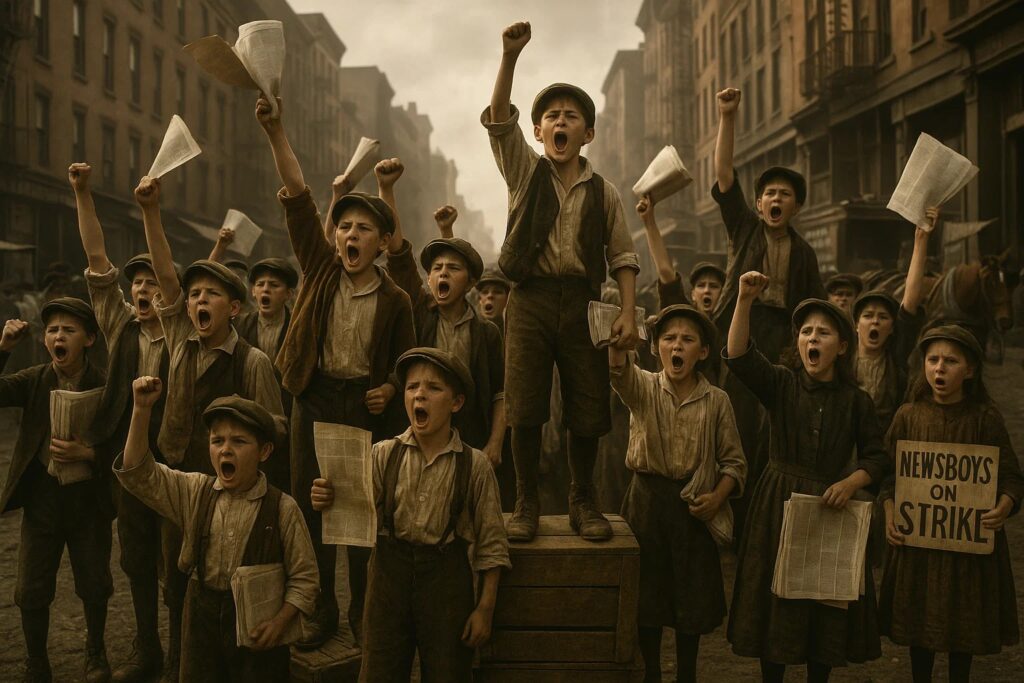
The answer is yes, but with a mix of truth and artistic invention. The musical draws inspiration from a real labor uprising known as the Newsboys’ Strike of 1899, a pivotal moment in American history that highlighted child labor, corporate greed, and the collective power of working-class youth. Yet the details you see in the movie and musical are not always what actually happened.
To understand the difference, let’s step into New York City at the turn of the century, when newspapers ruled the media landscape and thousands of children made their living selling “papes” on street corners.
The Real Story: The Newsboys’ Strike of 1899
The summer of 1899 was sweltering in New York City, and the children who hawked newspapers, often barefoot, sometimes as young as seven, were barely scraping by. These newsboys, or “newsies,” were not employees of the newspapers. Instead, they bought bundles of papers at wholesale prices and sold them for a small profit.
When publishers Joseph Pulitzer (New York World) and William Randolph Hearst (New York Journal) refused to roll back prices after the Spanish-American War ended, the newsies rebelled. They had been forced to buy bundles of 100 papers for 60 cents, and once the war frenzy, and soaring sales, ended, they couldn’t unload them all. That meant losing money for every unsold paper.
So, in July 1899, the boys went on strike. They organized rallies, marched through the streets, and even prevented “scabs” (replacement sellers) from working. Their main demand was simple: the publishers should buy back unsold papers.
The strike caught the city’s attention. Police clashed with the children. Grown men jeered at the idea of kids on strike. Yet the newsboys held their ground. At its peak, as many as 5,000 children were involved.
And here’s the twist: they won. Pulitzer and Hearst did not lower the price per bundle, but they agreed to buy back unsold papers, a compromise that protected the newsboys from devastating losses. It was a landmark victory for child workers and a demonstration of the power of collective action.
How Disney Transformed History into Musical
The real strike of 1899 is the backbone of Newsies. But Disney was not making a documentary, it was making a story that audiences would cheer for. And so, real history became the foundation for fictional drama.
Characters like Jack Kelly, Davey, and Spot Conlon never existed. They were invented to embody the spirit of the strike and give audiences central figures to root for. Songs like “Seize the Day” and “King of New York” made the struggle sound triumphant, even joyful, when in reality, the strike was gritty, exhausting, and dangerous.
Still, the emotional truth remained: the powerless fought back against the powerful, and for once, they won.
Did Teddy Roosevelt Really Help the Newsies?
One of the most memorable scenes in Newsies shows Theodore Roosevelt swooping in to save the day. In the movie, Roosevelt personally intervenes to stop the corruption of Joseph Pulitzer and support the children’s cause.
But history tells a different story. Roosevelt was governor of New York at the time, and while he was known for his progressive stance on reform, there’s no record of him directly helping the newsboys during their strike.
The connection is likely symbolic. Roosevelt later became known as a “trust-buster” and an advocate for workers’ rights, so Disney’s decision to include him fits the narrative of justice. But in reality, the newsies succeeded without him. Their victory was earned by their own courage, not the intervention of a political savior.
Was Jack Kelly Based on a Real Person?
Jack Kelly, the charismatic leader in Newsies, is pure fiction. There was no “Jack Kelly” who rallied the children. Instead, he represents the collective leadership of boys like Louis “Kid Blink” Baletti and David Simmons, who were actual strike leaders in 1899.
Kid Blink, in particular, became famous for his fiery speeches delivered in his thick New York accent. He once proclaimed to a cheering crowd:
“We’s got no use for scabs. If they can’t make money selling papes, let them go get a shine-box!”
Jack Kelly, then, is not one boy but many, a symbol of resilience, imagination, and leadership among the working-class youth.
Were There Girl Newsies in Real Life?
Disney’s film presents newsboys as almost entirely male, but history paints a more diverse picture. In truth, girls also sold newspapers, often working alongside their brothers or on their own. They faced the same dangers, poverty, and long hours as the boys.
Female newsies were especially visible in smaller cities and were often overlooked in the grander labor narratives of the time. While the Broadway production of Newsies eventually included female ensemble members, the original story largely erased them.
That absence has sparked conversations about gender representation in historical storytelling. The real strike was not just a “boys’ fight.” It was a movement led by children of all kinds, united by necessity.
The Controversy with the Newsies Musical
While Newsies has been celebrated for its energy and inspirational story, it has also faced criticism. Some historians argue that Disney over-romanticized the strike, turning a difficult chapter of child labor into a cheerful Broadway spectacle.
Others point out that by centering fictional male characters and ignoring real leaders like Kid Blink, or the existence of girl newsies, the show distorts history.
The controversy is not about whether Newsies is entertaining (it clearly is) but about what happens when entertainment becomes the primary way people learn about history. Do we lose sight of the truth when it’s packaged in song and dance?
Why the Story Still Resonates
Despite its liberties, Newsies continues to inspire. At its core, it’s about ordinary kids standing up against powerful institutions. The themes of justice, courage, and solidarity are timeless.
For many viewers, Newsies was their first exposure to the idea of labor strikes, unions, and child labor issues. In that sense, the musical has done more than just entertain, it has educated and sparked curiosity about the real history.
The true story of the Newsboys’ Strike of 1899 reminds us that change often begins with the marginalized, the overlooked, and the underestimated. Disney’s Newsies may have polished the facts, but it kept that essential truth intact.
Final Thoughts
So, is Newsies based on a true story? Yes, but it’s a story filtered through Broadway lights and Hollywood dreams. The strike of 1899 was real, the hardship of child labor was real, and the victory was real. But Jack Kelly never existed, Teddy Roosevelt didn’t ride in to save the day, and the grit of poverty was softened for family audiences.
Still, when the curtain falls or the credits roll, one thing remains: the spirit of kids who refused to be silenced. Their story deserves to be remembered, not just as a song and dance, but as a chapter of American history written by children with newspapers in their hands and justice in their hearts.

I am Jeremy Jahns – Your Cinematic Explorer
Immerse in movie reviews, Hollywood insights, and behind-the-scenes stories.